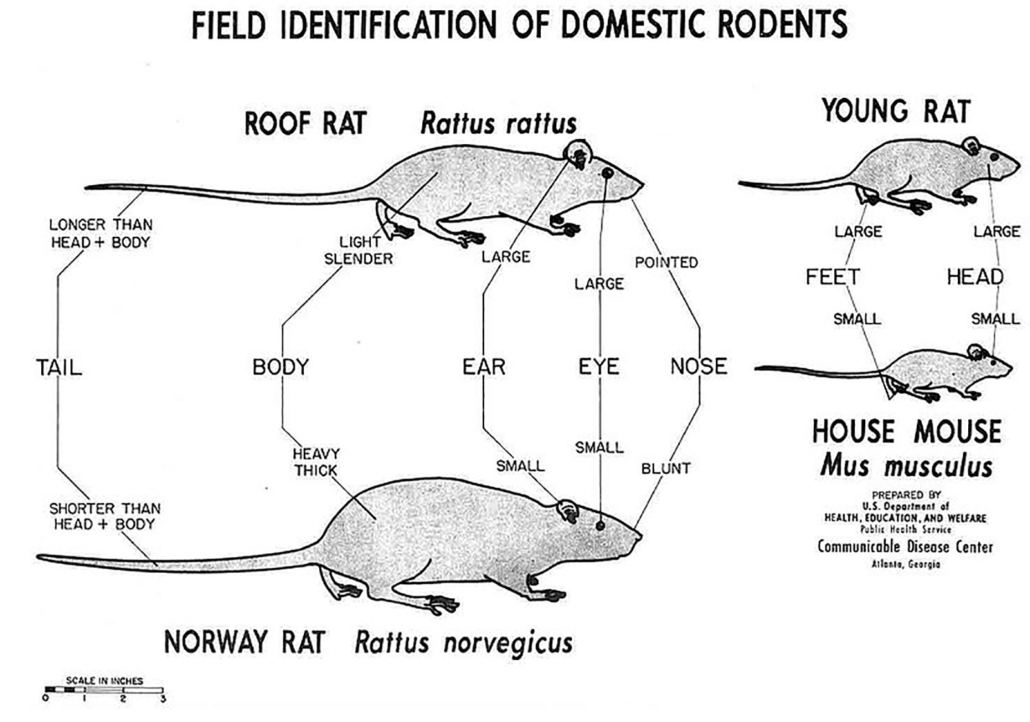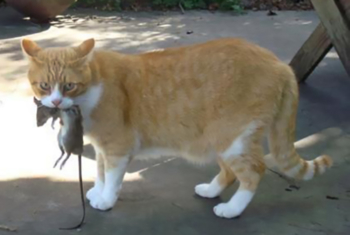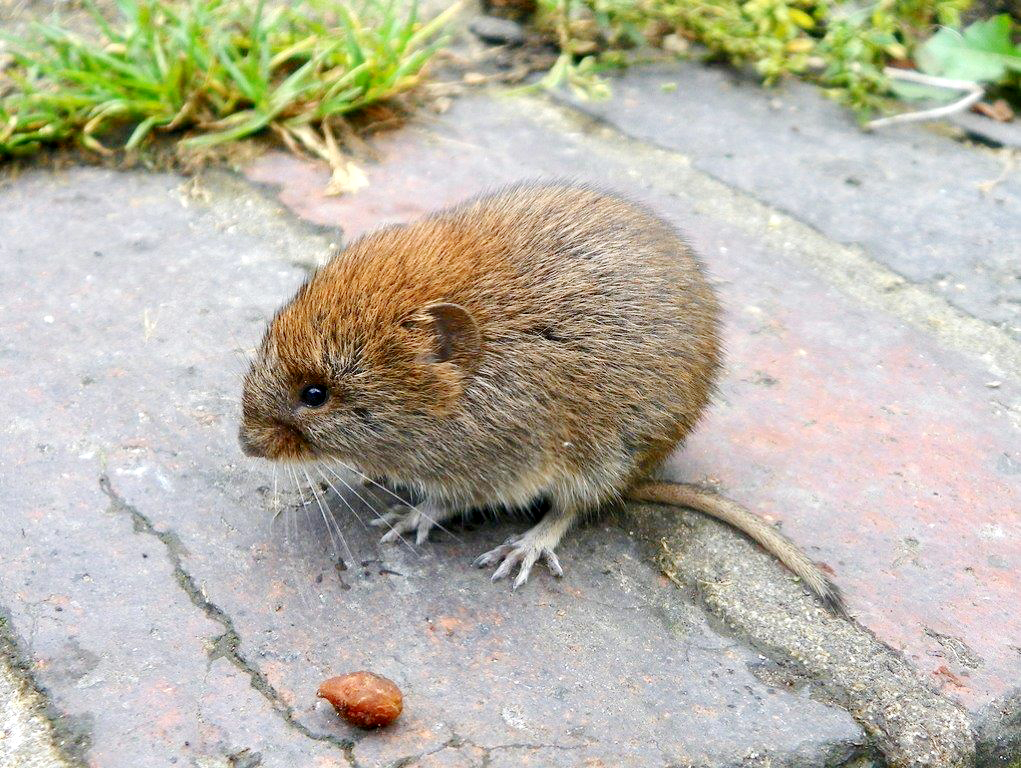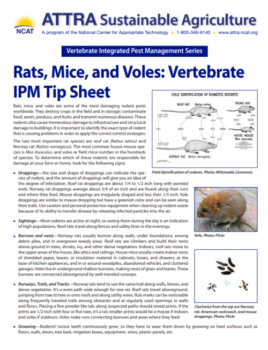Rats, Mice, and Voles: Vertebrate IPM Tip Sheet
Vertebrate Integrated Pest Management Series
By Martin Guerena, NCAT Agriculture Specialist
Introduction
Rats, mice, and voles are some of the most damaging rodent pests worldwide. They destroy crops in the field and in storage; contaminate food, seeds, produce, and fruits; and transmit numerous diseases. These rodents also cause tremendous damage to infrastructure and structural damage to buildings. It is important to identify the exact type of rodent that is causing problems in order to apply the correct control strategies.

Field identification of rodents. Photo: Wikimedia Commons
The two most important rat species are roof rat (Rattus rattus) and Norway rat (Rattus norvegicus). The most common house mouse species is Mus musculus, and voles or field mice number in the hundreds of species. To determine which of these rodents are responsible for damage at your farm or home, look for the following signs:
- Droppings. The size and shape of droppings can indicate the species of rodent, and the amount of droppings will give you an idea of the degree of infestation. Roof rat droppings are about ¼ to ½ inch long with pointed ends. Norway rat droppings average about ¾ of an inch and are found along their runs and where they feed. Mouse droppings are irregularly shaped and less than 1/3 inch. Vole droppings are similar to mouse dropping but have a greenish color and can be seen along their trails. Use caution and personal protective equipment when cleaning up rodent waste because of its ability to transfer disease by releasing infected particles into the air.
- Sightings. Most rodents are active at night, so seeing them during the day is an indication of high populations. Roof rats travel along fences and utility lines in the evenings.
- Burrows and nests. Norway rats usually burrow along walls, under foundations, among debris piles, and in overgrown weedy areas. Roof rats are climbers and build their nests above ground in trees, shrubs, ivy, and other dense vegetation. Indoors, roof rats move to the upper areas of the house, like attics and ceilings. House mice usually create indoor nests of shredded paper, leaves, or insulation material in cabinets, boxes, and drawers, at the base of kitchen appliances, and in or around woodpiles, abandoned vehicles, and cluttered garages. Voles live in underground shallow burrows, making nests of grass and leaves. These burrows are connected aboveground by well-traveled runways.
- Runways, Trails, and Tracks. Norway rats tend to use the same trail along walls, fences, and dense vegetation. It’s a worn path wide enough for one rat. Roof rats travel aboveground, jumping from tree to tree or onto roofs and along utility wires. Rub marks can be noticeable along frequently traveled trails among obstacles and at regularly used openings in walls and floors. Placing a fine powder like talc along suspected paths should reveal prints. If the prints are ½ inch with four or five toes, it’s a rat; smaller prints would be a mouse if indoors and voles if outdoors. Voles make runs connecting burrows and areas where they feed.
- Gnawing. Rodents’ incisor teeth continuously grow, so they have to wear them down by gnawing on hard surfaces such as floors, walls, doors, tree bark, irrigation boxes, equipment, wires, plastic panels, etc.
Rat, Mice and Vole Management
Successful management of rats, mice, and voles is a continuous commitment utilizing more than one control method. Complete control is not always possible, because of area-wide activities over which you have very little control, such as neglected structures nearby, abandoned fields, lack of predators, improper garbage disposal, and overgrown vegetation.
Habitat Modification. Many rodent problems may be minimized by making the farm and areas around buildings less hospitable to rodents through removing shelter and potential food and water. Remove debris including rocks, wood, and brush piles that can provide shelter for burrow entrances of the Norway rat and voles. Keep ground vegetation around buildings clear and trim the bottoms of hedges and other landscape plants up from the ground. Trim trees that overhang buildings back at least six feet. Avoid ivy, or any ground cover that would screen rats’ activities. If you have fruit or nut trees, make sure you pick up whatever falls on the ground. Store equipment, firewood, and other materials off the ground on pallets and away from building walls and fences. Clearing grassy areas and weeds will discourage voles by reducing their food and exposing them to predators and environmental stress.
Exclusion. In buildings, it is easier to keep rodents out than to get them out once they are inside. Seal, or screen with mesh wire, any opening larger than 1/4 inch, such as openings for water pipes, electrical and other utility cables, and vents. Sewer lines can have cleanouts that may provide access to rats, which can then get into the building. Materials used to restrict access include sheet metal to prevent climbing and gnawing, wire screen, steel wool, mortar, and concrete patches. Areas to inspect and use these materials include gaps or openings in roof tiles, roof vents, attic vents, gaps under entry doors, gaps around chimneys, crawl space covers, gaps under metal flashing, and heater or air-conditioning vents. Other preventative practices include clearing wood piles from the building, keeping storage sheds and animal hutches clean, trimming tree limbs near roofs, rodent-proofing the bird feeder, feeding pets periodically so there is no leftover pet food in the dish, and keeping trash containers sealed and away from the building. On farms it is a bigger challenge, because you are dealing with building structures, crops, animal facilities, and feed storage. Sanitation around the barn is critical: remove spilled feed, piled boxes, or anything rodents can hide in; block off entrances; and get rid of nesting materials. Remove food and water sources and keep feed in covered hoppers.
Baiting. The use of toxic baits can pose threats to wildlife, pets, and children, so they should be used with extreme caution. Baits accepted in certified organic production will be mentioned in this publication. For conventional baits, such as strychnine and anticoagulants, consult your local Extension website for guidance and always read the label of all pesticides.
• Vitamin D3 or Cholecalciferol-containing rodenticides, many of which are registered for use in organic systems, produce hypercalcemia, making them an effective poison with no secondary poisoning if a raptor, scavenger, or pet finds the poisoned rodent. Rodents generally die within two days following ingestion and do not appear to exhibit bait shyness. However, care should be used when placing this bait, particularly where pets are present and could access this poison, for which there is no antidote. Protected bait-box stations should keep pets and non-target animals away from the poison while making the bait accessible only to the target. In organic production, Vitamin D3 may only be used in conjunction with preventative management practices and only when those practices are not effective alone to prevent or control pests.

Snap trap. Photo: Wikipedia
Trapping. Trapping is an effective method of control for small areas or light infestations. Snap traps are very effective, inexpensive, and may require more labor, but are thought of as more humane, because they generally kill the rodent instantly. Baiting the traps with peanut butter, dried fruit or nuts, or dried pet food may be needed to lure the rodent to the traps. It’s good practice to tie the traps down (using twine, tying to a nearby pipe or beam, which will prevent too much movement of the trap), because you don’t want a wounded rodent dragging a trap to areas that you can’t access. Voles seldom wander from their runways and paths, so setting traps without bait at right angles in front of burrow entrances and paths can be effective. Norway rats travel along edges of buildings or against walls, so place the triggers against the walls and at entrances to a structure, where the rodent is forced through a narrow opening. Roof rats travel up beams, rafters, trees, and ledges, where traps can be fastened securely. If using snap traps outside, a trapping box may be necessary to protect non-target wildlife, pets, and children. Check traps daily to remove dead rodents and reset sprung traps quickly to prevent trap and bait shyness. Use gloves or plastic bags to remove dead rodents, because they may carry diseases.
Glue boards work like flypaper, trapping the rodent as it attempts to cross the board. With these types of traps, the rodent may not die quickly and you may need to kill it. Glue boards also lose their effectiveness in areas with high dust, debris, and high temperatures.
Electronic traps kill rats by electrocuting them with high-power batteries. They catch one rat at a time and are expensive compared to snap traps. The traps are convenient in some situations, especially with individuals who are squeamish about cleaning snap traps for reuse. The electrocuted rat slides out of the trap with minimal handling when the trap is emptied.
Live traps may be used, but are not recommended, because the rodents will have to be killed or released elsewhere. Releasing rodents to other areas may be illegal and will just transfer the problem to other areas. Releasing to wild areas will be disruptive to the natural ecosystem, and rats, especially, are known to decimate bird and reptile populations.

Domestic cats can help keep rat, mice, and vole populations down. Be aware that cats, especially feral cats, may prey on non-target organisms (birds, lizards), including endangered species. Photo: Martin Guerena, NCAT
Predators and Natural Control. Depending on the wildlife that lives in your region, many types of predators may be able to help reduce rodent populations. A healthy population of wild predators may include bobcats, foxes, coyotes, badgers, skunks, weasels, snakes, owls, ravens, hawks, and most other large birds of prey. Predation accounts for a large proportion of rodent mortalities, though it will not completely control a population.
It is, nonetheless, worthwhile to encourage predation—especially through the use of raptor (hawk and owl) platforms, nest boxes, and perches throughout the farm. Research has demonstrated that by attracting raptors to agricultural areas, pesticide use decreases (Lindell et al., 2018; Novak and Torfeh, 2017). USDA’s Natural Resources Conservation Service (NRCS) has funding to help farmers install wildlife structures on their land, as well as funding for many other conservation practices. Your local USDA Service Center can be located online here.
References
Lindell, C., R.A. Eaton, P.H. Howard, S.M. Roels, and M.E. Shave. 2018. Enhancing agricultural landscapes to increase crop pest reduction by vertebrates. Agriculture, Ecosystems and Environment. April 1. p. 1-11.
Novak, K. and D. Torfeh. 2017. Raptor Pilot Study for Levee Protection. Ventura County Public Works Agency Watershed Protection District.
Further Resources
Barn Owls in Integrated Pest Management and Sustainable Agriculture. 2017. By Barn Owl Box Company.
How to Prevent Mice in the Home and Garden. 2018. By The Old Farmer’s Almanac.
How to Get Rid of Voles Without Poison. 2018. By The Old Farmer’s Almanac.
IPM Action Plan for Rodents. 2018. By eXtension.
Pest of Homes, Structures, People, and Pets: Rats. 2011. By University of California Statewide Integrated Pest Management Program.
Voles: Learn about vole biology, food habits, damage caused by voles, and damage control methods. 2018. By Penn State Extension.
Rats, Mice, and Voles: Vertebrate IPM Tip Sheet
By Martin Guerena, NCAT Agriculture Specialist
Published December 2018
©NCAT
IP559, slot 583
This publication is produced by the National Center for Appropriate Technology through the ATTRA Sustainable Agriculture program, under a cooperative agreement with USDA Rural Development. This publication was also made possible in part by funding from the National Institute of Food and Agriculture, U.S. Department of Agriculture, award number 2013-51106-20970. ATTRA.NCAT.ORG.



